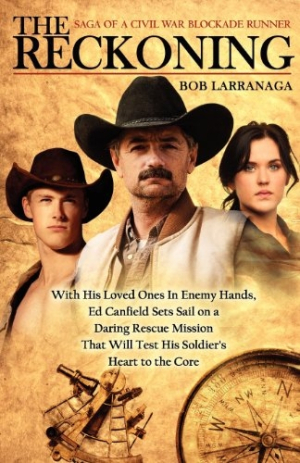The Reckoning
Saga of a Civil War Blockade Runner
In The Reckoning, Bob Larranaga delves into the backwaters of America’s Civil War to craft an adventure saga inspired by a pocket-sized journal his great-grandfather kept during that time.
Ed Canfield, a Mexican War veteran, returns home to his wife in Charleston after his service, but he soon finds himself back in uniform and assigned to an outpost in Florida. Bad luck and poor choices put him in the stockade. He never writes home, which ultimately leads to divorce. He doesn’t care. For one thing, he isn’t certain a son named Jesse, born only eight months after his return from Mexico, is really his child.
Canfield retreats to a piney wood homestead on Florida’s west coast, an area the author describes vividly. There, Canfield works the trees to make the pitch and pine tar that is used in shipbuilding. History buffs might find this one of the more interesting parts of the book. Larranaga’s research is evident. He discusses “plume hunters,” commercial hunters who shot birds for feathers to be used in fashion, which eventually led to species extinction; he also explains the origin of the word “cracker” as an nickname for Floridians.
The novel begins with minimal backstory. Canfield’s former wife sends their son, Jesse, to live with him, supposedly to keep the teenager out of danger. Simultaneously, a school teacher named Maureen Foster arrives. Canfield is frustrated with his obstinate son and attracted to Maureen. Both of these situations mark certain change in his life; for previously, when he wasn’t in the woods, he was in the bottle, haunted by his war experiences.
The narrative is straightforward, and the author offers a good picture of war hysteria as Abraham Lincoln takes office, by using a fire-breathing circuit preacher to reflect pro-slavery passions. Larranaga’s descriptions are colorful, as when he writes, “Fletcher gave me a wire-taut grin, barbed at both ends. Hoagg chewed on a quid of tobacco like a cow working on its cud.” That said, there is often an anachronistic air in the dialog: “Were you two kissing? Yuck”; “What in the world happened to you?”; “Just a little shook up.”
The war begins, and Union forces destroy the Cedar Key settlement along with Canfield’s business. Refugees retreat to a camp in the swamps, but they are plagued by an insufficient store of food and an epidemic of yellow fever. Canfield volunteers to sail through the blockade to Key West for medicine and supplies. While he’s at sea, the camp is seized by a rogue English pirate, but Canfield leads a rescue.
Rendered in the first person, the story unfolds rapidly enough to keep a reader turning pages. Action at sea and on land is believable, as is Canfield’s evolving reconciliation with his son and the promise of a future with Maureen. Larranaga writes movingly about the scourge of war, noting that it left Canfield forever scarred. However, there is confusion over the author’s use of the term “soldier’s heart,” which in some instances seems a term for post-traumatic stress and at other times a metaphor for courage in the face of adversity.
Civil War history buffs and those who enjoy military history in general will appreciate the unusual setting, but The Reckoning is less of a romantic history than might be assumed from the book’s cover.
Reviewed by
Gary Presley
Disclosure: This article is not an endorsement, but a review. The publisher of this book provided free copies of the book and paid a small fee to have their book reviewed by a professional reviewer. Foreword Reviews and Clarion Reviews make no guarantee that the publisher will receive a positive review. Foreword Magazine, Inc. is disclosing this in accordance with the Federal Trade Commission’s 16 CFR, Part 255.

